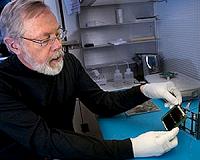 |
Los Angeles CA (SPX) Feb 01, 2010 Northrop Grumman monolithic microwave integrated circuits (MMICs) are flying aboard two state-of-the-art European Space Agency (ESA) space telescopes. The Herschel and Planck spacecraft are studying the formation of stars and galaxies, as well as relic radiation from the Big Bang. Using Herschel data, scientists earlier this year produced the most detailed images of deep space from 12 million years ago when the Universe teemed with newly formed stars. "Our high-performance MMICs enable key components for Herschel and Planck," said Dwight Streit, vice president of Emerging Technologies for Northrop Grumman Aerospace Systems. Herschel and Planck use transistors and MMICs developed in the company's microelectronics facility in Manhattan Beach, Calif. The circuits - designed at NASA, the Jet Propulsion Laboratory, ESA and Northrop Grumman - form the foundation of Herschel's and Planck's low-noise amplifiers and switches, as well as Herschel's terahertz (THz) local oscillator sources. The systems include the lowest noise MMIC-based millimeter wave radiometers and THz multiplier sources ever built. "We have a long history of designing and flying MMIC-based radiometers and amplifiers that demonstrate state-of-the-art performance," Streit said. Herschel, the largest space telescope ever launched with a 3.5-meter (11.5 feet) mirror, observes in the far-infrared and sub-millimeter wavelengths, allowing astronomers to see deep into star-forming regions, galactic centers and planetary systems. Planck, Europe's first mission to study relic radiation from the Big Bang, observes the cosmic background radiation: the radiation released into the universe by the Big Bang itself about 14 billion years ago. Planck will help answer how the universe came to be and how it evolved soon after. "This work continues Northrop Grumman's tradition of supplying state-of-the-art microelectronics technology for spacecraft applications, including radiometers for Jason 1, Odin, Cloudsat and the Microwave Limb Sounder program," said Richard Lai, director of Technology Programs for Northrop Grumman Microelectronics Processes and Products. "Our devices are also used in many ground-based applications around the world, including several ground-based telescopes that use them because of their state-of-the-art low-noise capability and their uniformity." Jason 1 was launched to monitor global ocean circulation, study the ties between the ocean and the atmosphere, improve global climate forecasts and predictions, and monitor events such as El Nino and ocean eddies. Odin was the first indium phosphide MMIC cryogenic amplifier to fly in space. It was designed to perform detailed studies of the physics and chemistry of the interstellar medium by observing emissions from key objects like giant molecular clouds and nearby galaxies. The company also supplied microwave amplifiers for the Cloudsat space-based radar that is used to study cloud formation to measure how much ice and water are in the air at various altitudes. The Microwave Limb Sounder in use on NASA's Aura spacecraft was created to help better understand the processes and parameters vital to global climate change research and environmental policy by observing the chemistry of Earth's lower stratosphere and upper troposphere.
Share This Article With Planet Earth
Related Links Herschel Planck Space Technology News - Applications and Research
 MSU Satellite To Accompany NASA Mission Into Space
MSU Satellite To Accompany NASA Mission Into SpaceBozeman MT (SPX) Jan 29, 2010 It's official. A small research satellite that Montana State University students built to commemorate the 50th anniversary of the first successful U.S. satellite will ride into space this fall on a NASA launch. Calling it "a historically huge moment," David Klumpar, director of MSU's Space Science and Engineering Laboratory, said this will be the first time that an MSU satellite will be la ... read more |
|
| The content herein, unless otherwise known to be public domain, are Copyright 1995-2010 - SpaceDaily. AFP and UPI Wire Stories are copyright Agence France-Presse and United Press International. ESA Portal Reports are copyright European Space Agency. All NASA sourced material is public domain. Additional copyrights may apply in whole or part to other bona fide parties. Advertising does not imply endorsement,agreement or approval of any opinions, statements or information provided by SpaceDaily on any Web page published or hosted by SpaceDaily. Privacy Statement |